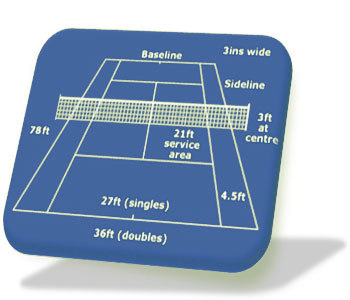Tennis – Rules of the Game
A PDF file of Tennis Canada’s – “Rules of the Court” can be downloaded here.
Simplified Rules Of Tennis

- Whoever wins the toss gets to choose who will serve first or which side of the net the players will take. The choice not taken is made by the loser of the coin toss. You may win the toss but give your opponent the choice of serve/receive or sides.
- The server must serve diagonally into the service box across the court. He or she must serve from a stationary position behind the baseline, between the centre mark and sideline — the singles sideline for singles and the doubles sideline for doubles.
- The server gets two chances to hit a good serve. A missed serve is called a “fault”. The serve is a fault if the server swings and misses the ball. The server may stop the serve by catching the ball and starting over. The server may serve underhand, but he or she may not bounce the ball before hitting it. The server may not serve before the receiver is ready.
- The receiver must let the serve bounce before touching it. In doubles, the receiver’s partner may not touch the served ball.
- The net is defined as being the net, centre strap and metal cable between, but not including the netposts or singles sticks. If a served ball touches the net but lands in, it is replayed because the net interfered. On any other shot in the game, however, if the ball touches the net and lands in, it remains in play.
- You lose the point if you fail to return an opponent’s good shot before the second bounce.
- You lose the point if your shot lands outside the lines. A shot landing on a line or touching any part of the line is good. Each player or team calls the lines on their side of the net, so your shots are called by your opponents. You may question their calls, but must abide by them.
- You lose the point if your shot hits the ground or a permanent fixture outside the lines before it bounces. Permanent fixtures outside the lines include umpire chairs, stands, fences, roof, lights or curtains.
- You lose the point if you hit the ball more than once (accidental double hits caused by racket wobble don’t count). You lose the point if you or anything you wear or carry (at the beginning of the point) touches the net or the court on your opponent’s side. You lose the point if the ball hits you or your partner or anything you wear or carry (other than your racquet).
- You lose the point if you hit the ball before it has crossed to your side of the net. You lose the point if you let the ball go back by itself (e.g., in a heavy wind or due to heavy backspin) without touching it. In other words, you must return the ball. Your follow-through may pass over the net. If the ball is going back on its own, having already been on your side, you may make contact with it on your opponent’s side of the net. But in neither case may you touch the net or the opponent’s court.
- If unintentional interference occurs, play a let, starting the point over. If a player hinders his or her opponent’s shot by some intentional act, that player loses the point.
- In doubles, the teams setup their serving order and receiving sides at the beginning of each set. They can switch their serving order or receiving side at the beginning of each set.
- If anything gets mixed up, like serving order, playing ends or receiving side, you simply correct the situation as soon as you discover the error. But you do not replay any finished points. They stand as played, even if the wrong person served them or served them into the wrong court. However, in doubles receiving errors are corrected at the end of the game and if the error in serving is noticed after the game is complete, the service order remains as altered.
- The principal unwritten rule of tennis is that, in calling lines, give the benefit of any doubt to your opponent. In other words, if you aren’t absolutely certain the ball was out, judge and call it in.
Please review the full OTA Code of Conduct for tournament and league play.
